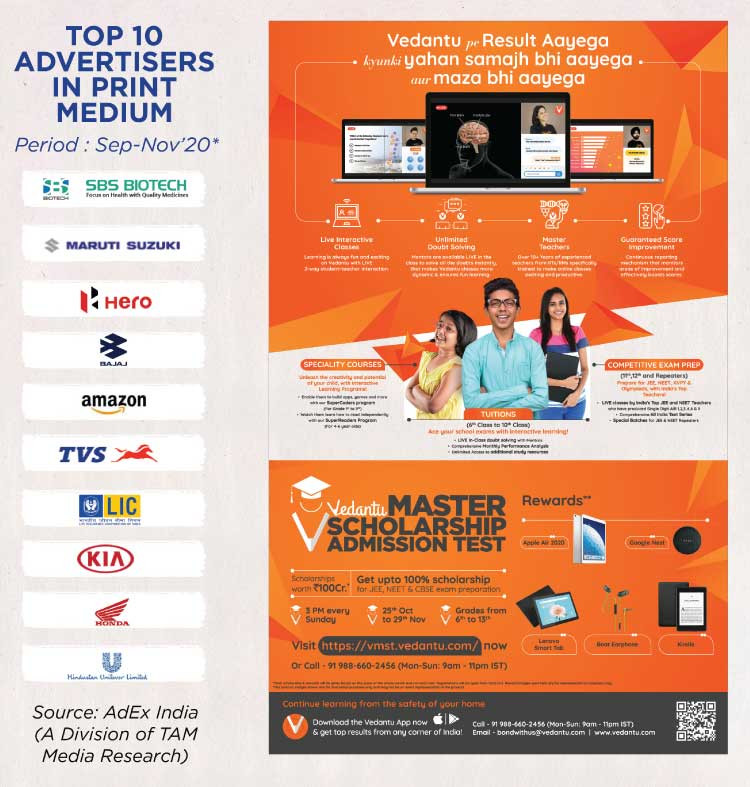In March and April this year, newspapers in major cities like Mumbai had to stop printing for some time owing to the pandemic. Apart from the distribution troubles during the lockdown there was a big fear of contracting the coronavirus through the paper delivered at the doorstep. So much so that newspapers like Hindustan Times released an ad assuring its readers that ‘the paper itself is safe, all plants are fumigated and sanitised regularly and printing process is totally automated’. Thinner editions, sparsely populated by ads were characteristics of most of the newspapers, post lockdown. Eight months later, while there is no sign of an end to the pandemic, newspapers have definitely sprung back to action. Recently during Diwali, across multiple regions, Dainik Bhaskar released a bumper edition. Mathrubhumi, despite Diwali not being the biggest festival in Kerala, released a special edition on Diwali with rich ad support. Not just the regional newspapers, even English dailies like Times of India and Hindustan Times saw bigger editions for the festive season just ahead of Diwali. Does that mean distribution has reached pre-COVID levels, and has the reliance of the advertiser on the medium which once commanded second highest share of the AdEx returned unscathed after an obvious gap?
As per Probal Ghosal, Director, Amar Ujala, the newspaper’s circulation is now at 92% of the pre-COVID times and ad volumes at over 80%. He says, “Since the markets have re-opened from July, we have seen an upward thrust in Print month-on-month with each succeeding month better than the previous one and now the festive season giving impetus to this ongoing trend. If you look at it, some print dependent categories like auto, FMCG and education had already started advertising post the lockdown and now with festivals, there is a further boost to the spends to capture the consumers attention with both local and national advertisers using Print to reach out to audiences.”
HIGH ON CREDIBILITY
The initial months of the pandemic saw record breaking viewership for Television news while breaks in the physical delivery of print media also gave Digital news consumption a boost. But Ghosal claims that once again advertisers are falling back on Print as a credible medium for news, owing to the recent controversies surrounding Television News. “Conversations on the quality of TV content and BARC suspending TRP ratings during the prime festive period will further boost up the print AdEx as brands are taking cognizance of the fact that being associated with the right medium is essential for acquiring the trust of their consumers, hence a bigger share of the pie. Though one fundamental challenge is of bridging the gap between the price and discount – and how to optimise yield in a situation where advertisers are also facing similar problems of market demand.”

As far as the advertisers are concerned, they are claiming COVID-19 helped make the Print medium more economical for advertising. For brands like Mother Dairy which have a stronger presence in North India and specifically Delhi-NCR, Print still serves well to get a targeted, city specific and focused reach. Sanjay Sharma, Business head, Dairy Products, Mother Dairy says, “While the new generation is not catching up with Print, there is a substantial population of 35+ like me whose day doesn’t start if they don’t get their newspaper in the morning. We still feel there is a lot of meat in Print. Advertising on Print had become very expensive prior to COVID-19, so this is a blessing in disguise. As they faced challenging times, they understood that new rates are a win-win for agencies and brands, especially for a company like ours which believes in reaching as many consumers as possible and having as many touch points as possible.”
THE FESTIVE IMPETUS
But despite an obvious decrease in ad rates, regional players have done a good job of fighting back. Shailesh Gupta, Director, Jagran Prakashan Ltd says that the run up to the festive season was very encouraging and the celebrations will give a fillip to the Print industry. He says, “As per an EY survey, newspapers are the most credible source of news and information during this crisis. Our markets are oozing confidence and the consumers are up and about in markets. The key factors that have led to the recovery is clearly linked to the severity of the pandemic across geographies – from Jagran’s point of view, our supply chain wasn’t impacted much and as a result most of our key states (barring Delhi) also weren’t. We’re now back to over 90% of our pre-COVID circulation numbers. With positivity rates coming down and active cases on the wane, consumer confidence is leading the road to recovery.”
Print has been sending out a clear message of a comeback since August with some bulky 50 page editions being released by key regional players. Consumer durables, FMCG, real estate and auto are some of the active advertising sectors on Print. As per Tarun Jha, Head of Marketing and Product, Skoda Auto India, “Most advertisers during the festive season believe in a 360 degree approach. Of course one has to keep adjusting a little bit, like sometimes you spend more on Digital, sometimes on Television or Print. But it is a known fact that Print in certain markets works better. We do our math and certainly won’t discard Print. Almost all automotive advertisers are using Print right now because everybody still believes in it. We had stopped spending on Print in the initial days of lockdown but now our ad spends on Print are back to pre- pandemic days and we are spending on both, regional and national newspapers.”
On the other hand BFSI brands like Edelweiss are still calculating the odds, Radhika Gupta, CEO, Edelweiss AMC says, “We have used Print media extensively in the past during the Bharat Bond campaign. We are yet to see post lockdown what our approach to print media will be. Digital will dominate spends but we are not ruling out traditional forms just yet. We have to see how things play out.”
Real estate has been another category which has heavily depended on Print advertising in the past, but was missing from action in the initial months post lockdown. Parikshit Pawar, Senior Vice President and Head of Marketing, Shapoorji Pallonji Real Estate (SPRE) explains, “As an advertiser we are aware that print subscriptions have surely dropped post pandemic. However, the need to know about ‘what’s happening in the world’ remains thus a large portion of customers have moved to consuming news online through apps or news portals. We have not chosen Print as a medium in the last few months, however we won’t rule out the usage of Print at a regional level for our upcoming project launches. We may consider a combination of their online advertisements along with their offline piece for a more assured and wider reach.”
THE SOUTH STORY
On the other hand, down South, key players are claiming that Print has emerged stronger than what it was during the lockdown and circulation revenues are intact even if ad revenues have fallen. As per Varghese Chandy, VP Marketing, Advertising Sales, Malayala Manorama the newspaper brand did experience an uptick in advertising during Onam this year, but it was understandably far off from last year’s advertising revenues. But with the reach of Print in Kerala being the highest in India, advertising in Print is expected to definitely improve with the easing of the COVID restrictions and an improvement in consumer confidence. Chandy explains, “One of the challenges that we face is that advertisers/advertising agencies tend to perceive that the circulation of dailies in Kerala has gone down drastically, as may have been the case in other parts of the country. We were fortunate to not be in this situation as newspapers were declared an essential service by the state government right from the early stages of the pandemic and our distribution networks were not interrupted. In fact our circulation revenue is intact, which helped the company’s cash flow.”
Shreyams Kumar, MD, Mathrubhumi Group also agrees that Kerala has been on the upper curve of recovery when compared to Print in the rest of the country. “Kerala as a market largely remained unimpacted. Even during the peak lockdown, independent surveys by large consulting companies, epitomised Kerala in terms of distribution of newspapers. I believe Kerala is now working at 100% of the distribution and readership. And the good news for us is that, we have registered a sizeable monthly average growth too which we are sure will result in our favour in the next round of ABC.”

WHAT THE PRINT PLAYERS HAVE TO SAY
 “Our circulation is now at 92% of the pre-COVID times and ad volumes at approximately 80%. Conversations on the quality of TV content and BARC suspending TRP ratings during the prime festive period, will further boost up the print AdEx.”
“Our circulation is now at 92% of the pre-COVID times and ad volumes at approximately 80%. Conversations on the quality of TV content and BARC suspending TRP ratings during the prime festive period, will further boost up the print AdEx.”
Probal Ghosal
Director, Amar Ujala “From Jagran’s point of view, our supply chain wasn’t impacted much and as a result most of our key states (barring Delhi) also weren’t. We’re now back to over 90% of our pre-COVID circulation numbers.”
“From Jagran’s point of view, our supply chain wasn’t impacted much and as a result most of our key states (barring Delhi) also weren’t. We’re now back to over 90% of our pre-COVID circulation numbers.”
Shailesh Gupta
Director, Jagran Prakashan Ltd “Newspapers were declared an essential service by Kerala government right from the early stages of the pandemic, and so our distribution networks were not interrupted. In fact, our circulation revenue is intact which helped the company’s cash flow.”
“Newspapers were declared an essential service by Kerala government right from the early stages of the pandemic, and so our distribution networks were not interrupted. In fact, our circulation revenue is intact which helped the company’s cash flow.”
Varghese Chandy
VP Marketing, Advertising Sales, Malayala Manorama “The good news for us is that, we have registered a sizeable monthly average growth in circulation, which we are sure will result in our favour in the next round of ABC.”
“The good news for us is that, we have registered a sizeable monthly average growth in circulation, which we are sure will result in our favour in the next round of ABC.”
Shreyams Kumar
MD, Mathrubhumi Group  “Who is worried about the third party audit? The agencies? The clients? Then how they are buying ads on large digital platforms? On the other hand, we are all witnessing what’s happening with a third party audited data for television viewing.”
“Who is worried about the third party audit? The agencies? The clients? Then how they are buying ads on large digital platforms? On the other hand, we are all witnessing what’s happening with a third party audited data for television viewing.”
Partha Sinha
President, Response, Times Group
Lack of advertisements was of course evident in the April-May-June period. Yet the Print industry has been steadily recovering. Talking about the Kerala market, Kumar observes, “We consider ourselves fortunate to experience two festival seasons in quick succession, one being our regional festival of Onam and the other the national festival of Diwali. Onam was a good indicator for us. Coming straight out of the peak of COVID-19, we managed to deliver exceptional performance during Onam and the trends since then seem to suggest that there’s no looking back. Kerala always attracts a good share of the advertisers’ money on the print medium, owing to the very high consumption of Print. In fact, Kerala is the only state where overall Print reach is higher than that of TV.”
ADVANTAGE REGIONAL PLAYERS
Giving a perspective from the brand’s side, Nipun Marya, Director Brand Strategy, Vivo says, “Print offers the flexibility of picking up regions, unlike TV. I was speaking to some print media houses and they said that in the non-apartment areas, i.e. standalone houses their circulation has pretty much gone back to normal. So, I think it all depends on which particular region one’s target audience lies in. For e.g. If I have to target a place like Gurgaon, Bangalore or Mumbai where a lot of condominiums and apartments are there, I will think two times before advertising in Print because I know their circulation is hit there. But the non-metros where there are a lot of standalone houses, circulation is back to the pre-COVID times. And therefore, I don’t see a big challenge if somebody wants to advertise in non-metros.”
So what happens to the English dailies which are prominent in these metros like The Times of India? Partha Sinha, President, Response, Times Group says that despite the challenges they have never given very deep discounts, and in October, their ad rates in many markets were back to pre-COVID levels, He elaborates, “Yes, the regional language papers recovered circulation faster. There are two reasons for that. Firstly, metros had a lot more restricted zones and stricter norms than small towns – and regional papers have little play in most metros. Secondly, the regional papers had audience that took chances earlier. Our audience is very premium and are hyper conscious of health and took a longer time to accept the paper inside home. But all these factors are behind us and we have recovered circulation across the country. Though I must admit it was a more difficult task with the metro crème de la crème audience that we cater to. But then, that’s the reason we are the brand we are. People who matter read the Times of India and the Economic Times.”
And yet many advertisers argue that an audit is the need of the hour and the print industry should give out the real circulation numbers as there is a lot of confusion over the pricing and circulation numbers across many markets. Some Print leaders like Varghese Chandy agree. Chandy says, “We believe that there should be a metric for advertisers to measure reach. We have audited figures by Chartered Accountants to show our numbers are not affected, but as per ABC norms, we are not allowed to use the same. We look forward to the ABC circulation audits commencing at the earliest.”
But Partha Sinha says that the call for updated circulation only shows double standards on the part of agencies and advertisers, He asks, “Who is very worried about the third party audit? The agencies? The clients? Then how they are buying ads on the large digital platforms? None of those platforms ever give third party audited data. Then, how come they are reconciling? Honestly speaking, third party audit is secondary – the primary objective of advertising should be effectiveness. If by putting an ad you are getting commensurate results in the marketplace then you know the value of that ad. On the other hand, we are all witnessing what’s happening with a third party audited data for television viewing. What’s the next step? A police certificate along with the data? Whenever it’s possible ABC will be revived and in my opinion nobody needs to lose sleep over it.”
India has for years defied the global trend of print media losing readership. At the onset of the pandemic, experts expected COVID-19 to suffocate the Print in the country with the rapid adoption of Digital even by the elderly population. But even through distribution troubles, Print has shown resilience. Asha Kharga, Group Marketing Head, Axis Bank notes, “Most of the publications’ circulation numbers have reached 75-80%, as claimed by the publication themselves. Advertisers are considering print as a medium, and it is surely getting revived with key sectors like auto, e-commerce and consumer durables actively advertising during the festive season on Print. From an audience perspective as well, while people did get into the habit of consuming news through the e-paper and pdfs, they have started subscribing back to the physical papers. While this year we have not advertised in Print till now, we will evaluate it for our future campaigns basis the objectives of those campaigns.”























